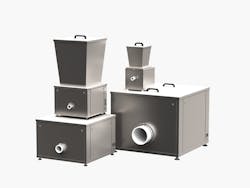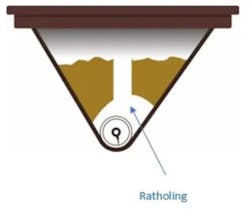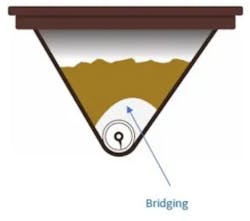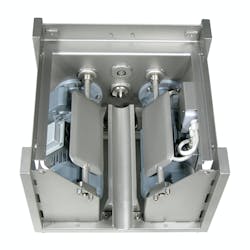Understanding ratholing and bridging phenomena in bulk powder feeding
Bulk powder handling is a crucial aspect of various industries, including pharmaceuticals, food processing, and chemical manufacturing. Consistent and reliable flow of powder from storage to processing equipment is essential for maintaining production efficiency. Ratholing and bridging are common issues that can disrupt the uniformity of powder discharge from feeders, leading to operational inefficiencies and product quality concerns.
Ratholing
Ratholing occurs when a preferential flow path is established within a bulk powder material, causing the powder to channel through a specific region of a hopper while remaining stagnant in other regions, as shown in Figure 2. This phenomenon leads to uneven material discharge, resulting in inconsistent feed rates and potential quality issues in the final product. The factors contributing to ratholing include powder particle size distribution, cohesive forces between particles, and the design of the storage vessel and feeding equipment.
Mechanisms of ratholing
Ratholing can be attributed to several mechanisms, including particle size segregation, cohesion, and friction. Fine particles may fill the voids between larger particles, creating channels that persist throughout the feeding process. Additionally, cohesive forces between particles can promote the formation of stable flow channels, further exacerbating the ratholing effect.
Mitigating ratholing
A number of methods and design innovations can be used to address ratholing issues. For example, through precise design of the feeder and hopper geometry, Hapman minimizes the likelihood of particle segregation and cohesive forces that contribute to ratholing. The use of vibration and fluidization techniques helps to maintain powder homogeneity within the feeder, preventing the formation of preferential flow paths.
Bridging
Bridging occurs when a stable arch or crust forms over the outlet of a storage vessel, preventing the uniform discharge of powder, as shown in Figure 4. This phenomenon is particularly common in materials with cohesive or adhesive properties. Factors such as particle size, moisture content, and environmental conditions can influence the likelihood of bridging.
Mechanisms of bridging
The formation of bridges is often a result of powder consolidation, agglomeration, or the development of cohesive forces between particles. When these forces exceed the weight of the powder above the outlet, a stable arch is formed, obstructing the flow of material.
Mitigating bridging
To mitigate bridging, Hapman dosing machines come equipped with a feature known as the Flexible Wall Hopper. This innovative hopper is made of sustainable polyurethane with a flexible exterior that ensures optimal performance. By incorporating external mechanical paddles, as shown in Figure 5, the hopper gently massages and keeps the dry material in the hopper in constant motion, facilitating a smooth transfer towards the dosing screw. Unlike traditional methods, such as interior agitators, that may cause particle damage or hinder flow, the dry material remains intact without any risk of ratholing or bridging. Thanks to this unique setup, even poorly flowing and compacting raw materials can be easily and accurately dosed. Additionally, operators can adjust the speed of both the screw and paddles independently to achieve the perfect settings for the application.
Hapman (800-427-6260) offers a range of bulk material handling equipment, including tailored and advanced feeding solutions to help processors in industries such as foods, pharmaceuticals, and chemicals overcome bulk powder ratholing and bridging challenges.
Hapman
www.hapman.com




